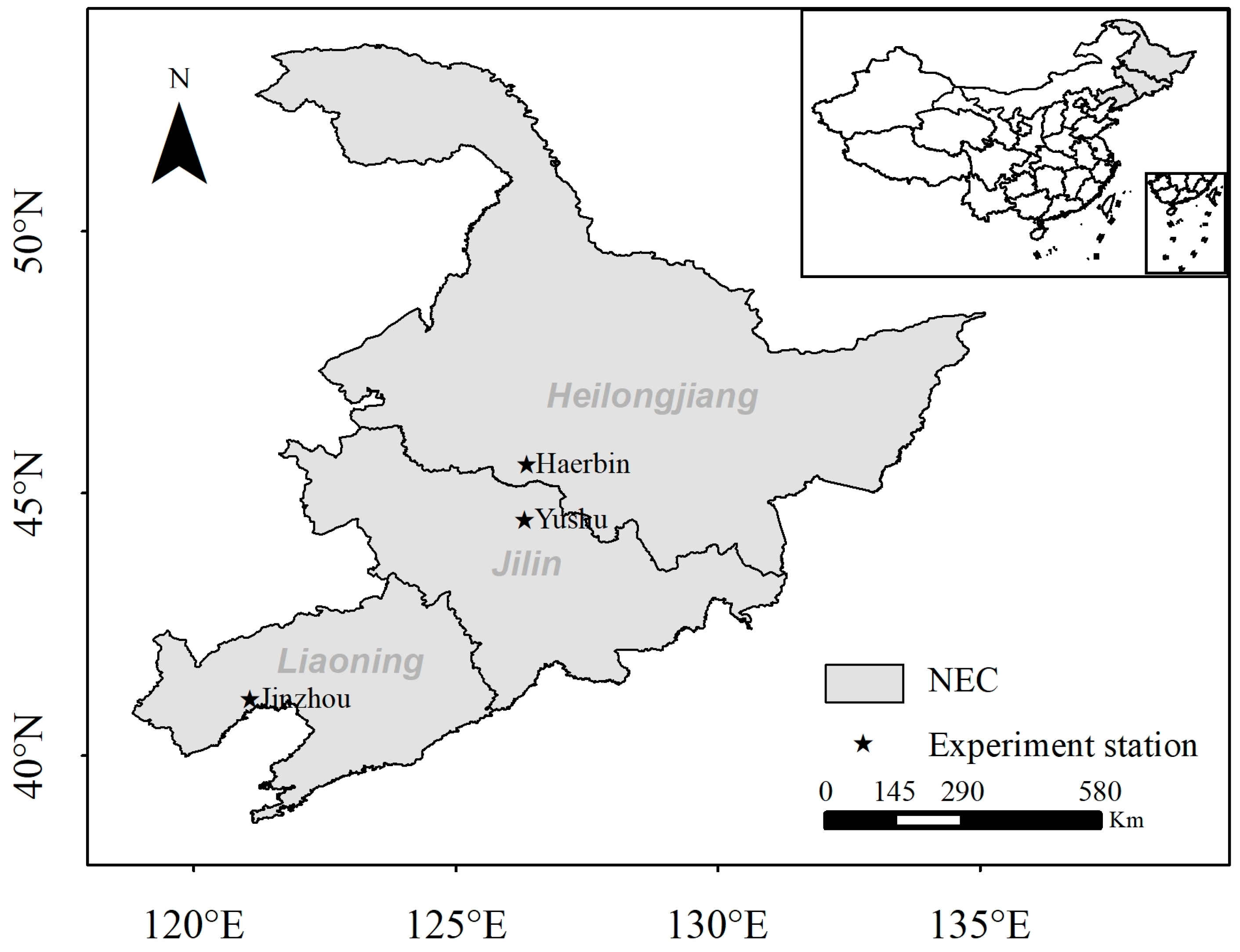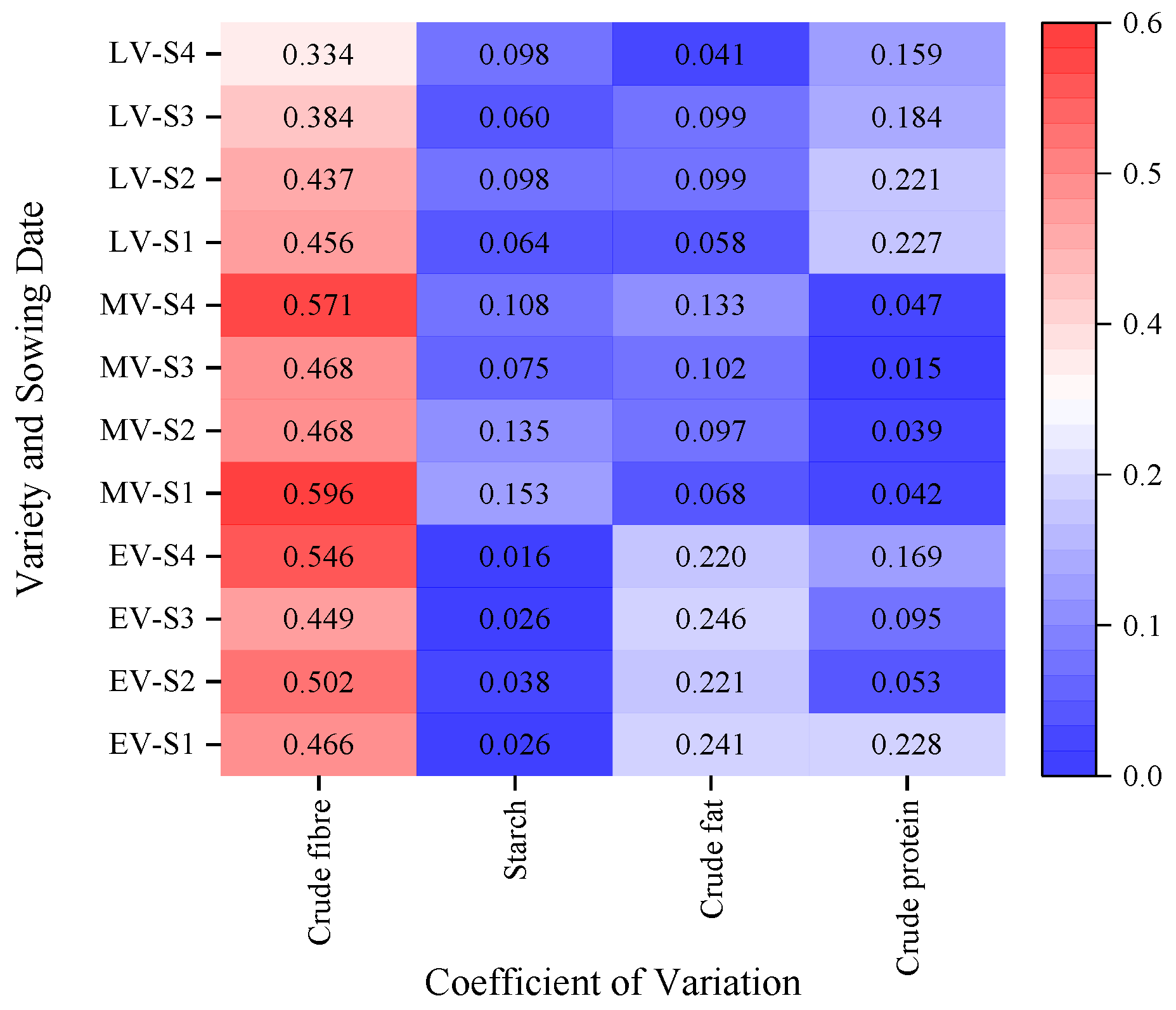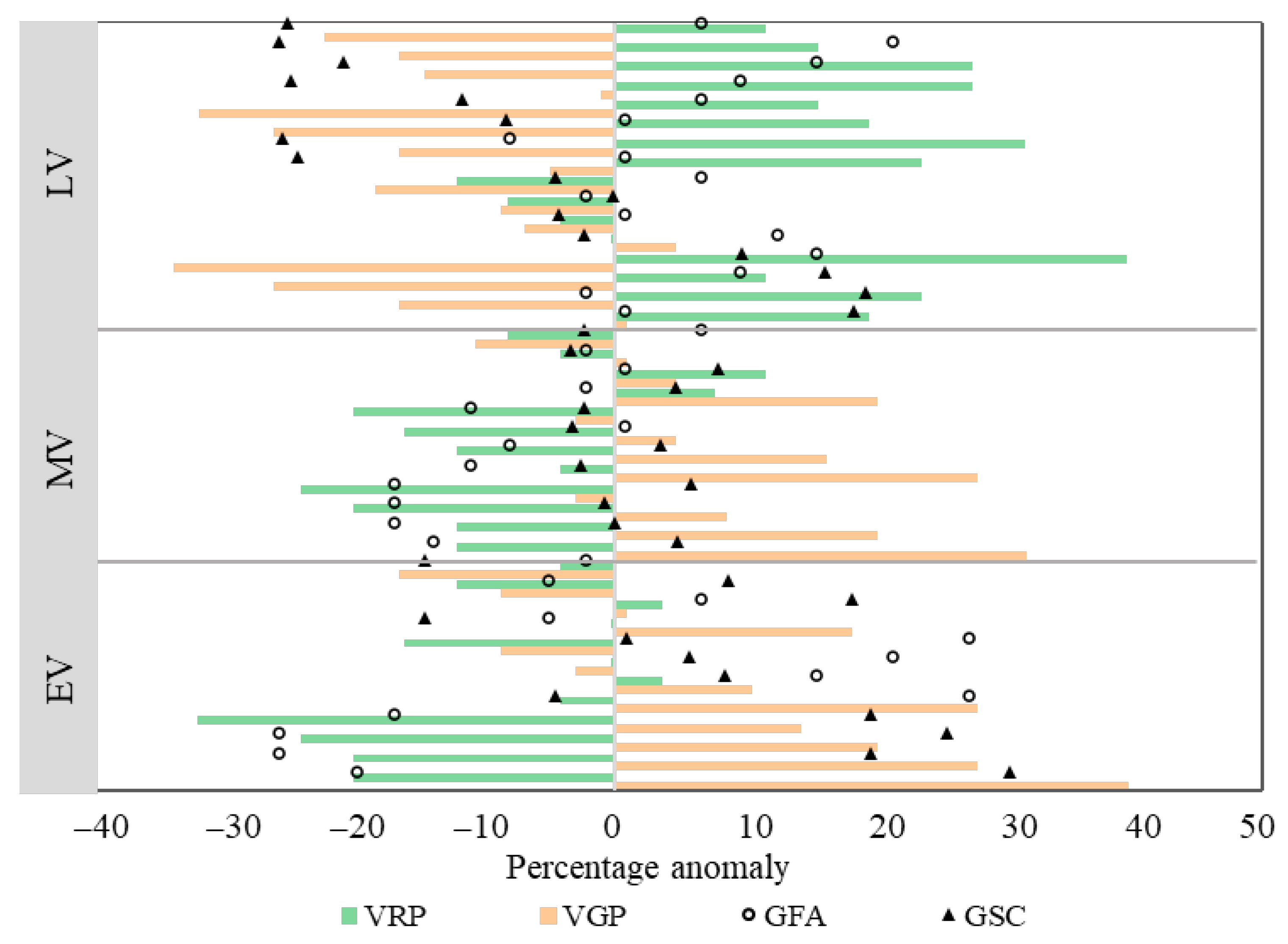The Effect of Sowing Date on the Nutritional Quality of Kernels of Various Maize Varieties in Northeast China
Abstract
:1. Introduction
2. Materials and Methods
2.1. Study Region
2.2. Experiment Design
2.3. Measurements and Calculations
2.3.1. Maize Measurements
2.3.2. Growth Stage Division
2.3.3. Total Solar Radiation
2.3.4. Active Accumulated Temperature
2.3.5. Stable KNQ Index
2.3.6. Partial Correlation Analysis
2.4. Data Analysis
3. Results
3.1. Variation Characteristics of Maize KNQ of Different Varieties
3.2. Effects of Sowing Date on Maize KNQ of Different Varieties
3.3. Relationship between KNQ and Climatic Resources and the Length of Growth Stages
4. Discussion
5. Conclusions
Author Contributions
Funding
Conflicts of Interest
References
- National Bureau of Statistics of China. Available online: http://www.stas.gov.cn/ (accessed on 16 August 2023).
- Nuss, E.T.; Tanumihardjo, S.A. Maize: A paramount staple crop in the context of global nutrition. Compr. Rev. Food Sci. F. 2010, 9, 417–436. [Google Scholar] [CrossRef]
- Ranum, P.; Peña-Rosas, J.P.; Garcia-Casal, M.N. Global maize production, utilization, and consumption. Ann. N. Y. Acad. Sci. 2014, 1312, 105–112. [Google Scholar] [CrossRef]
- Chander, S.; Meng, Y.; Zhang, Y.; Yan, J.; Li, J. Comparison of nutritional traits variability in selected eighty-seven inbreds from Chinese maize (Zea mays L.) germplasm. J. Agr. Food Chem. 2008, 56, 6506–6511. [Google Scholar] [CrossRef] [PubMed]
- Shah, T.R.; Prasad, K.; Kumar, P. Maize-a potential source of human nutrition and health: A review. Cogent Food Agr. 2016, 2, 1166995. [Google Scholar]
- Ali, J.; Amna; Mahmood, T.; Hayat, K.; Afridi, M.S.; Ali, F.; Chaudhary, H.J. Phytoextraction of Cr by maize (Zea mays L.). The role of plant growth promoting endophyte and citric acid under polluted soil. Arch. Environ. Prot. 2018, 44, 73–82. [Google Scholar] [CrossRef]
- Shen, S.; Zhang, L.; Liang, X.G.; Zhao, X.; Lin, S.; Qu, L.H.; Liu, Y.P.; Gao, Z.; Ruan, Y.L.; Zhou, S.L. Delayed Pollination and Low Availability of Assimilates Are Major Factors Causing Maize Kernel Abortion. J. Exp. Bot. 2018, 69, 1599–1613. [Google Scholar] [CrossRef] [PubMed]
- Shen, S.; Ma, S.; Chen, X.; Yi, F.; Liang, X.G.; Liao, S.; Gao, L.; Zhou, S.L.; Ruan, Y.L. A Transcriptional Landscape underlying Sugar Import for Grain Set in Maize. Plant J. 2022, 110, 228–242. [Google Scholar] [CrossRef]
- Shen, S.; Ma, S.; Wu, L.; Zhou, S.L.; Ruan, Y.L. Winners Take All: Competition for Carbon Resource Determines Grain Fate. Trends Plant Sci. 2023, 28, 893–901. [Google Scholar] [CrossRef]
- Jahangirlou, M.R.; Akbari, G.A.; Alahdadi, I.; Soufizadeh, S.; Parson, D. Grain Quality of Maize Cultivars as a Function of Planting Dates, Irrigation and Nitrogen Stress: A Case Study from Semiarid Conditions of Iran. Agriculture 2021, 11, 11. [Google Scholar] [CrossRef]
- Yang, J.N.; Lai, X.F.; Shen, Y.Y. Response of dual-purpose winter wheat yield and its components to sowing date and cutting timing in a semiarid region of China. Crop Sci. 2022, 62, 425–440. [Google Scholar] [CrossRef]
- Sun, W.; He, Q.; Liu, J.; Xiao, X.; Wu, Y.; Zhou, S.; Ma, S.; Wang, R. Dynamic monitoring of maize grain quality based on remote sensing data. Front. Plant Sci. 2023, 14, 1177477. [Google Scholar] [CrossRef]
- Rotger, A.; Ferret, A.; Calsamiglia, S.; Manteca, X. Effects of nonstructural carbohydrates and protein sources on intake, apparent total tract digestibility, and ruminal metabolism in vivo and in vitro with high-concentrate beef cattle diets. J. Anim. Sci. 2006, 84, 1188–1196. [Google Scholar] [CrossRef] [PubMed]
- Agetsuma, N.; Agetsuma-Yanagihara, Y.; Takafumi, H.; Nakaji, T. Plant constituents affecting food selection by Sika Deer. J. Wildl. Manag. 2019, 83, 669–678. [Google Scholar] [CrossRef]
- Paraginski, R.T.; Vanier, N.L.; Berrios, J.D.J.; de Oliveira, M.; Elias, M.C. Physicochemical and pasting properties of maize as affected by storage temperature. J. Stored Prod. Res. 2014, 59, 209–214. [Google Scholar] [CrossRef]
- Ureta, C.; González, E.J.; Espinosa, A.; Trueba, A.; Piñeyro, N.A.; Elena, R.Á. Maize yield in Mexico under climate change. Agric. Syst. 2020, 177, 102697–102707. [Google Scholar] [CrossRef]
- Wang, L.Q.; Gao, J.L.; Wang, F.G.; Ma, D.L.; Yu, X.F.; Guo, H.H. Analysis of yield and grain nutrient quality of maize varieties from 1970s to 2010s. J. China Agric. Univ. 2023, 28, 44–60, (In Chinese with English abstract). [Google Scholar]
- He, Q.; Zhou, G.; Liu, J. Progress in Studies of Climatic Suitability of Crop Quality and Resistance Mechanisms in the Context of Climate Warming. Agronomy 2022, 12, 3183. [Google Scholar] [CrossRef]
- Xu, J.Q.; Qian, C.; Sun, Y.K.; Zhou, Y.J. Effects of different sowing date on yield and quality of maize. Heilongjiang Agric. Sci. 2019, 8, 32–34, (In Chinese with English abstract). [Google Scholar]
- Yang, H.; Shi, Y.L.; Lu, D.L.; Lu, W.P. Effect of sowing date on starch physicochemical properties of summer waxy maize. J. Nucl. Agric. 2016, 30, 1754–1762, (In Chinese with English abstract). [Google Scholar]
- Lu, D.L.; Cai, X.M.; Zhao, J.Y.; Shen, X.; Lu, W.P. Effects of drought after pollination on grain yield and quality of fresh waxy maize. J. Sci. Food. Agric. 2015, 95, 210–215. [Google Scholar] [CrossRef]
- Zhou, W.; Cui, F.Z.; Duan, H.K.; Hao, G.H.; Yang, H.; Liu, R.R. Effects of sowing date on yield and quality of waxy maize. Crops 2020, 2, 156–161, (In Chinese with English abstract). [Google Scholar]
- Wang, P.W.; Dai, J.Y.; Wei, Y.P. The effects of drought stress on yield and quality of maize. J. Maize. Sci. 1999, 1, 102–106, (In Chinese with English abstract). [Google Scholar]
- Wang, L.Q.; Yu, X.F.; Gao, J.L.; Ma, D.L.; Guo, H.H.; Hu, S.P. Patterns of influence of meteorological elements on maize grain weight and nutritional quality. Agronomy 2023, 13, 424. [Google Scholar] [CrossRef]
- Lu, T.Q.; Zhang, H.; Shui, H.X.; Jiang, X.F.; He, D.; Pang, Q.H.; Wang, X.Q. Effect of sowing date on yield and quality of maize under rain-fed conditions in hilly area of Sichuan Province. Bull. Agri. Sci. Tech. 2019, 12, 87–93, (In Chinese with English abstract). [Google Scholar]
- GB/T 5009.10-1985; Determination of Crude Fiber in Vegetable Foods. Ministry of Health of the People Republic of China: Beijing, China, 1985.
- GB/T 5009.9-2003; Determination of Starch in Foods. Ministry of Health of the People Republic of China: Beijing, China, 2003.
- GB 5009.6-2016; National Food Safety Standard Determination of Fat in Foods. National Health and Family Planning Commission of the PRC; State Food and Drug Administration: Beijing, China, 2016.
- GB/T 5009.5-2003; Determination of Protein in Foods. Ministry of Health of the People Republic of China: Beijing, China, 2003.
- He, Q.; Xie, Y. Research on climatology calculation methods of total solar radiation in China. J. Nat. Resour. 2010, 25, 308–319, (In Chinese with English abstract). [Google Scholar] [CrossRef]
- Allen, R.G.; Pereira, L.; Raes, D.; Smith, M. Crop evapotranspiration-guidelines for computing crop water requirements. In FAO Irrigation and Drainage Paper 56; Food and Agriculture Organization: Rome, Italy, 1998. [Google Scholar]
- Yadav, S.; Deb, P.; Kumar, S.; Pandey, V.; Pandey, P.K. Trends in major and minor meteorological variables and their influence on reference evapotranspiration for mid-Himalayan region at east Sikkim, India. J. Mt. Sci. 2016, 13, 302–315. [Google Scholar] [CrossRef]
- Liu, J.; He, Q.; Zhou, G.; Song, Y.; Guan, Y.; Xiao, X.; Sun, W.; Shi, Y.; Zhou, K.; Zhou, S.; et al. Effects of Sowing Date Variation on Winter Wheat Yield: Conclusions for Suitable Sowing Dates for High and Stable Yield. Agronomy 2023, 13, 991. [Google Scholar] [CrossRef]
- Wilding, L.P.; Dress, L.R. Spatial Variability and Pedology; Wilding, L.P., Smeck, N., Hall, G.F., Eds.; Pedogenesis and Soil Taxonomy: Wageningen, The Netherlands, 1983; pp. 83–116. [Google Scholar]
- Shi, S.; Li, W.; Lin, X.P.; Zhai, Y.C.; Ding, Y.S. Spatiotemporal variations of vegetations NDVI and influencing factors in Heilongjiang Province. Res. Soil Water Conserv. 2023, 30, 294–305, (In Chinese with English abstract). [Google Scholar]
- Shen, S.; Liang, X.G.; Zhang, L.; Zhao, X.; Liu, Y.P.; Lin, S.; Gao, Z.; Wang, P.; Wang, Z.; Zhou, S.L. Intervening in Sibling Competition for Assimilates by Controlled Pollination Prevents Seed Abortion under Postpollination Drought in Maize. Plant Cell Environ. 2020, 43, 903–919. [Google Scholar] [CrossRef]
- Shen, S.; Li, B.B.; Deng, T.; Xiao, Z.D.; Chen, X.M.; Hu, H.; Zhang, B.C.; Wu, G.; Li, F.; Zhao, X.; et al. The Equilibrium between Sugars and Ethylene Is Involved in Shading and Drought-Induced Kernel Abortion in Maize. Plant Growth Regul. 2020, 91, 101–111. [Google Scholar] [CrossRef]
- Zhang, L.; Yang, Y.; Luo, Y.M.; Zhou, J.H.; Yin, Y.; Liu, J.Y.; Xu, Y.F.; She, Y.H. Effects of sowing date on seed quality formation and yield of spring soybean. Crops 2015, 2, 118–123. [Google Scholar]
- Butts, W.C.; Seebauer, J.R.; Singleton, L.; Below, F.E. Weather During Key Growth Stages Explains Grain Quality and Yield of Maize. Agronomy 2019, 9, 16–30. [Google Scholar] [CrossRef]
- Barutçular, C.; Dizlek, H.; EL-Sabagh, A.; Sahin, T.; Elsabagh, M.; Islam, M.S. Nutritional quality of maize in response to drought stress during grain-filling stages in mediterranean climate condition. J. Exp. Biol. Agric. Sci. 2016, 4, 644–652. [Google Scholar] [CrossRef]
- Yu, S.N.; Gao, J.L.; Ming, B.; Wang, Z.; Zhang, B.L.; Yu, X.F.; Sun, J.Y.; Liang, H.W.; Wang, Z.G. Quantification planting density based on heat resource for enhancing grain yield and heat utilization efficiency of grain mechanical harvesting maize. Chin. J. Eco-Agric. 2021, 29, 2046–2060, (In Chinese with English abstract). [Google Scholar]






| Station | Year | Active Accumulated Temperature (°C·d) | Mean Temperature (°C) | Maximum Temperature (°C) | Minimum Temperature (°C) | Solar Radiation (MJ·m−2) | Precipitation (mm) |
|---|---|---|---|---|---|---|---|
| Haerbin | 2018 | 3268.8 | 18.1 | 23.4 | 13.1 | 3149.6 | 593.7 |
| 2019 | 3092.0 | 17.6 | 23.2 | 12.6 | 3276.9 | 575.9 | |
| 2021 | 3160.1 | 18.1 | 23.1 | 13.4 | 3216.5 | 546.7 | |
| Yushu | 2018 | 3278.6 | 18.2 | 23.8 | 12.8 | 3114.7 | 448.2 |
| 2019 | 3089.5 | 17.7 | 23.6 | 12.3 | 3324.1 | 725.7 | |
| 2020 | 3080.5 | 17.4 | 23.0 | 12.5 | 3222.0 | 620.7 | |
| Jinzhou | 2018 | 3832.3 | 21.1 | 26.2 | 16.9 | 3547.6 | 362.4 |
| 2019 | 3838.3 | 21.2 | 26.4 | 16.5 | 3611.1 | 546.5 | |
| 2020 | 3705.5 | 20.7 | 25.7 | 16.3 | 4242.1 | 421.1 | |
| 2021 | 3680.8 | 20.2 | 24.8 | 16.3 | 3140.7 | 859.8 |
| Sowing Station | Maturity/Variety | Year | Sowing Date |
|---|---|---|---|
| Haerbin | Early-maturing Zengyu1317 | 2018 | 4/25 |
| 5/5 | |||
| 5/15 | |||
| 5/24 | |||
| Early-maturing Hongshuo298 | 2019 | 4/25 | |
| 5/5 | |||
| 5/15 | |||
| 5/24 | |||
| Early-maturing Keyu15 | 2021 | 4/25 | |
| 5/5 | |||
| 5/16 | |||
| 5/25 | |||
| Yushu | Medium-maturing Xianyu335 | 2018–2020 | 4/21 |
| 5/1 | |||
| 5/11 | |||
| 5/21 | |||
| Jinzhou | Late-maturing Danyu405 | 2018–2021 | 4/20 |
| 4/30 | |||
| 5/10 | |||
| 5/20 |
| Variety | KNQ | KFI | KSC | KFA | KPC |
|---|---|---|---|---|---|
| EV | KFI | ||||
| KSC | 0.369 | ||||
| KFA | −0.479 | −0.544 | |||
| KPC | 0.676 * | −0.656 * | −0.147 | ||
| MV | KFI | ||||
| KSC | −0.057 | ||||
| KFA | −0.691 * | −0.540 | |||
| KPC | 0.343 | −0.363 | −0.008 | ||
| LV | KFI | ||||
| KSC | 0.580 * | ||||
| KFA | 0.125 | 0.352 | |||
| KPC | 0.931 ** | −0.510 | −0.179 |
| Variety | Source of Variation | KFI | KSC | KFA | KPC |
|---|---|---|---|---|---|
| EV | Year | 983.5 ** | 2.2 | 238.1 ** | 70.7 ** |
| Sowing date | 2.3 | 0.1 | 2.3 | 13.9 ** | |
| Year × Sowing date | 5.3 ** | 0.5 | 3.7 ** | 10.2 ** | |
| MV | Year | 1102.5 ** | 62.8 ** | 40.6 ** | 1.7 |
| Sowing date | 14.5 ** | 1.6 | 0.7 | 2.6 * | |
| Year × Sowing date | 9.6 ** | 2.3 * | 3.2 * | 1.7 | |
| LV | Year | 689.6 ** | 30.2 ** | 13.1 ** | 172.4 ** |
| Sowing date | 3.2 * | 0.2 | 4.4 * | 1.6 | |
| Year × Sowing date | 6.6 ** | 0.6 | 5.3 ** | 4.3 ** |
| Growth Period | Influence Factor | KFI | KSC | KFA | KPC |
|---|---|---|---|---|---|
| VGP | ATT | 0.323 * | 0.505 ** | −0.635 ** | 0.557 ** |
| days | 0.049 | 0.367 * | −0.478 ** | 0.394 * | |
| VRP | ATT | 0.036 | −0.418 ** | 0.443 ** | −0.397 * |
| days | −0.040 | −0.464 ** | 0.501 ** | −0.427 ** | |
| RGP | ATT | 0.307 | −0.333 * | 0.291 | −0.204 |
| Mean temperature | 0.178 | −0.349 * | 0.365 * | −0.417 ** | |
| Maximum temperature | 0.231 | −0.359 * | 0.308 | −0.377 * | |
| Minimum temperature | 0.112 | −0.347 * | 0.394 * | −0.452 ** | |
| Total solar radiation | 0.211 | −0.435 ** | 0.174 | −0.191 | |
| Total precipitation | −0.569 ** | −0.214 | 0.323 * | −0.584 ** | |
| Diurnal temperature range | 0.268 | 0.201 | −0.471 ** | 0.482 ** |
Disclaimer/Publisher’s Note: The statements, opinions and data contained in all publications are solely those of the individual author(s) and contributor(s) and not of MDPI and/or the editor(s). MDPI and/or the editor(s) disclaim responsibility for any injury to people or property resulting from any ideas, methods, instructions or products referred to in the content. |
© 2023 by the authors. Licensee MDPI, Basel, Switzerland. This article is an open access article distributed under the terms and conditions of the Creative Commons Attribution (CC BY) license (https://creativecommons.org/licenses/by/4.0/).
Share and Cite
Liu, J.; He, Q.; Wu, Y.; Xiao, X.; Sun, W.; Lin, Y.; Yi, R.; Pan, X. The Effect of Sowing Date on the Nutritional Quality of Kernels of Various Maize Varieties in Northeast China. Agronomy 2023, 13, 2543. https://doi.org/10.3390/agronomy13102543
Liu J, He Q, Wu Y, Xiao X, Sun W, Lin Y, Yi R, Pan X. The Effect of Sowing Date on the Nutritional Quality of Kernels of Various Maize Varieties in Northeast China. Agronomy. 2023; 13(10):2543. https://doi.org/10.3390/agronomy13102543
Chicago/Turabian StyleLiu, Jiahong, Qijin He, Yixuan Wu, Xiao Xiao, Weiwei Sun, Yujing Lin, Rui Yi, and Xuebiao Pan. 2023. "The Effect of Sowing Date on the Nutritional Quality of Kernels of Various Maize Varieties in Northeast China" Agronomy 13, no. 10: 2543. https://doi.org/10.3390/agronomy13102543




